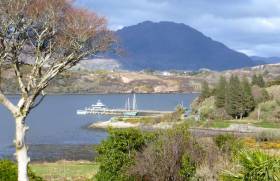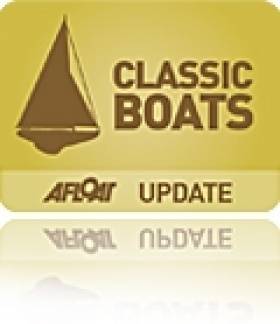Displaying items by tag: Ainmara
Vintage Dublin Yawl Ainmara Celebrates Centenary+Ten With Return To Ringsend Birthplace
The 36ft yawl Ainmara, designed and built in 1912 by the talented self-taught naval architect John B Kearney in Murphy’s Boatyard beside his family’s home in Ringsend, played a key role in Irish sailing north and south until 2018. She celebrated her Centenary in 2012-2013 with a special cruise to the Outer Hebrides followed by overall victory in the first race for the Dublin Bay Old Gaffers Association Leinster Plate in Dublin Bay, and then in 2016 she was awarded the “Boat of the Regatta” trophy in the Royal Ulster YC 150th Anniversary Regatta on Belfast Lough.
Her final owner in Ireland, - from 1966 until 2018 - was multi-talented skipper Dickie Gomes of Strangford Lough. But when he put her up for sale after more than fifty years of ownership, he found there was even more interest internationally than there was at home, and she was sold to a Swiss couple, Nicco Macchi and Marie Vuilleumier, who made Ainmara’s new home port in Dunkerque.
 Happy live-aboards – Niccho Macchi and Marie Vuilleumier in Ainmara’s decidedly compact saloon. The photo on the bulkhead is of Ainmara racing from Inverness to Bergen fifty years ago in 1972 under Dickie Gomes’ command. Photo: W M Nixon
Happy live-aboards – Niccho Macchi and Marie Vuilleumier in Ainmara’s decidedly compact saloon. The photo on the bulkhead is of Ainmara racing from Inverness to Bergen fifty years ago in 1972 under Dickie Gomes’ command. Photo: W M Nixon
This provided a handy base to cruise to classic and traditional events in The Netherlands, Belgium, France and southern England while continuing to work in Switzerland. But they enjoyed the cruising so much that after a major refit including a new deck in Ostende in Belgium, they cut their shore ties for the time being, and moved aboard to make Ainmara their floating home.
 The new deck is a very neat piece of work. John B Kearney disliked heavily-cambered decks, and Ainmara and other boats to his design - such as the famous Mavis of 1925 - were renowned for decks with the right amount of camber for constructional strength, while providing easy on-deck movement. Photo: W M Nixon
The new deck is a very neat piece of work. John B Kearney disliked heavily-cambered decks, and Ainmara and other boats to his design - such as the famous Mavis of 1925 - were renowned for decks with the right amount of camber for constructional strength, while providing easy on-deck movement. Photo: W M Nixon
The plan for 2022 was to sail north into the Baltic and then along the west coast of Norway to Bergen, where Ainmara had been in 1972 at the conclusion of the stormy Clyde Cruising Club’s Inverness-Bergen Race. From Norway it was across to Scotland and through the North Channel to the Down Cruising Club’s converted lightship HQ in Strangford Lough and a reunion with Dickie Gomes, and then it was on to Howth – where she won the Lambay Race in 1921 – before making her call to Ringsend.
 Niccho and Marie with the “non-folding sprayhood”. Long before folding sprayhoods were thought of, a 1950s owner fitted Ainmara with this useful item of comfort. Inevitably during the course of cruises, the handy space under it tended to become the stowage repository for all sorts of essential little items, but with Swiss ownership it’s now a notably neat and tidy area. Photo: W M Nixon
Niccho and Marie with the “non-folding sprayhood”. Long before folding sprayhoods were thought of, a 1950s owner fitted Ainmara with this useful item of comfort. Inevitably during the course of cruises, the handy space under it tended to become the stowage repository for all sorts of essential little items, but with Swiss ownership it’s now a notably neat and tidy area. Photo: W M Nixon
When people become liveaboards, they usually become subtly different – or sometimes very different - to the rest of us. But even though Nicco and Marie have to go with the tides and the weather independently of land-bound routines, when you meet them you wouldn’t think for a moment that their home is aboard a small and ancient sailing boat. It must be because they’re Swiss, yet that’s something they wear lightly. But whatever the reason, they and Ainmara are as neat and organised as can be.
And while their life is largely freeform, as a result of a successful visit to the Dartmouth Classics in south Devon they were very committed to being there again on July 12th this year – next Tuesday – and a recent position check showed Ainmara was already in Cornish waters, on time with quiet efficiency. She’s an ever-young Irish boat which happens to be 110 years old. And clearly this latest chapter in her remarkable story is as interesting as everything that has gone before.
 “Where next?” Ainmara’s proud bowsprit always seemed like an encouraging invitation to go cruising to interesting places, and under Swiss ownership with a home port in Basel, she is regularly heading “for other places beyond the seas”. Photo: W M Nixon
“Where next?” Ainmara’s proud bowsprit always seemed like an encouraging invitation to go cruising to interesting places, and under Swiss ownership with a home port in Basel, she is regularly heading “for other places beyond the seas”. Photo: W M Nixon
For this week's Sailing on Saturday we take a look back eight years when WM Nixon cruised from Ireland to the Outer Hebrides in the 36-foot vintage restored sloop Ainmara
#hebrides – August is almost upon us. The heat has been fierce, and the summer season has been busy. Despite some blips in the weather, civilised folk will be thinking of sailing away from it all for a while. North and west perhaps, in the hope of finding uncrowded and beautiful places which may be cooler. The Western Isles, the Outer Hebrides, are calling us away.
Certainly they did so in August last year, but not for reasons of heat. On the contrary, the jetstream lay persistently along Ireland's south coast, and July's weather here was appalling. But the word came back that up in the Hebrides, they were already thinking of water shortages as the sun shone on and on.
We had contemplated taking the 1912-built 36ft Kearney yawl Ainmara to southwest Ireland for her Centenary cruise. But as owner Dickie Gomes is an enthusiast for the west coast of Scotland in any case, it was no contest. Twelve days in mid-August were allocated to celebrating the old girl's emergence from a 27-year restoration with some Hebridean island-hopping. And I became so taken with the idea that I made an offer that if we could get to the remote little pool of Rodel at the southern tip of Harris, I'd stand my two shipmates the Centenary Dinner at the inn beside that enchanted anchorage.
Rodel is a real honey-trap, as you need a good rise of the tide to get through the drying channel into the deep pool, and there you are - whether you like it or not - until the tide returns. But it's no hardship, as the place is beautiful, the inn is welcoming, and for a thoughtful insight into times past in the Western Isles, just up the road is the restored late mediaeval church of St Clement, complete with the famous MacLeod tomb with its carving of a sailing vessel, the inspiration for Wallace Clark's building of the Lord of the Isles galley with which he voyaged from Connacht to Stornoway.
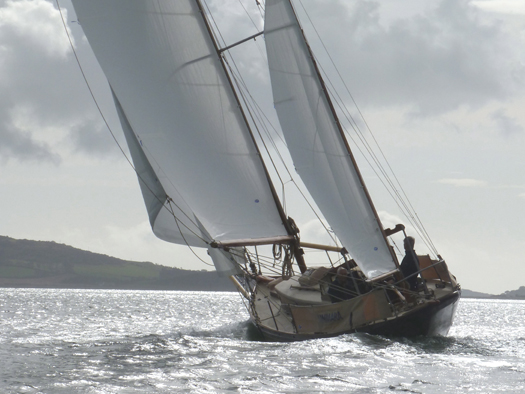 The Centenarian on a silver sea – after a restoration lasting 27 years, Ainmara deserved to spend her hundredth birthday at a very special place Photo: W M Nixon
The Centenarian on a silver sea – after a restoration lasting 27 years, Ainmara deserved to spend her hundredth birthday at a very special place Photo: W M Nixon
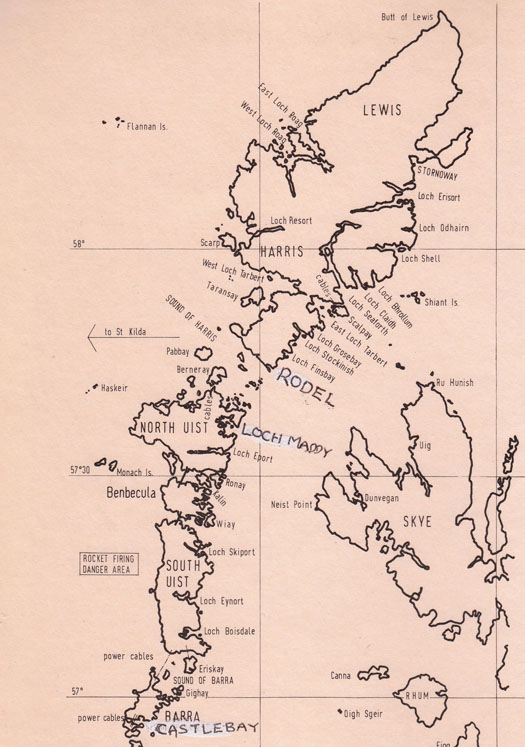 The cruise objective – Rodel is exactly in the middle of the long necklace of the Outer Hebrides
The cruise objective – Rodel is exactly in the middle of the long necklace of the Outer Hebrides
It's the sort of place that everyone thinks they are the first to discover, and my own first discovery of Rodel came in 1977 when we sailed in aboard Johnny Roche's 26ft South Coast OD Safina. The party in the inn was mighty, and dawn was already hinting when we struck a deal in the old kitchen to buy a bolt of Harris tweed, woven within sight of the anchorage. We sailed home with the tweed in a sailbag in the foc's'le, and two of the crew then commissioned that great Dublin tailor Jack O'Rourke (father of current Mermaid National Champion Jonathan O'Rourke) to make them up a couple of suits from our seafaring cloth.
Although they both were of much the same age, one was an old fogey from birth, while the other was a permanently young trendy. So when Jack finally produced the suits to their two very different and clearly defined specifications, it took a real effort to realize that both outfits were cut from the same piece of tweed, as one was a very sharp and fashionable bit of work, while the other had all the timeless style of a sack of potatoes.
Next time back to Rodel was six years later with my own Hustler 30 Turtle, and some of those good folk of Rodel with whom we'd partied in '77 had since gone to the great weaving mill in the sky, while the inn was running out of steam. It still clung to some semblance of gentility with immaculate table linen, but portions for dinner were of such modest size that we simply had two dinners apiece, one after the other.
That was all of thirty years ago, and since then the word was the inn had closed down completely. But a few years ago there was a welcome whisper of a restoration under completely new ownership. So when Ainmara's centenary came up the agenda, it seemed the perfect setting for a mid-cruise Centenary Dinner, and we departed from Ballycastle towards the sunny Hebrides with this interesting cruise objective in mind, while astern the Irish coast continued to lie under cloud.
Despite his impressive record of international long distance offshore racing, these days Dickie Gomes takes care to avoid unnecessary nights at sea, so our progress towards Rodel was gentle yet effective, hopping our way via Port Ellen and Ardbeg in Islay, then on to Scalasaig in Colonsay, and then out to Tiree to be nicely placed for the passage across the Sea of the Hebrides to Barra.
There'd been only one other yacht in Gott Bay in Tiree when we arrived, but there were half a dozen getting under way in leisurely style that morning. Ainmara was the only boat to head west out through Gunna Sound between Tiree and Coll into the Sea of the Hebrides, shaping our course for Barra and motoring gently through a large shoal of basking sharks going about their leisurely work. There was a strengthening breeze from the northeast and the soft grey cloud cover was melting away. It may have been three days already since leaving Ballycastle, but coming out through Gunna Sound gave a special feeling of the cruise really getting under way, and it settled into a perfect 40 mile passage, beam reaching in sunshine with everything set to the jib tops'l on its first outing, and the distinctive peaks of the southern outliers of the Western Isles starting to rise above the horizon while still thirty miles ahead.
 First port in the Outer Hebrides - Castlebay in Barra revelled in the August sunshine Photo: W M Nixon
First port in the Outer Hebrides - Castlebay in Barra revelled in the August sunshine Photo: W M Nixon
Castlebay basked in the sun, the heat was solid, and the tarmac on the quayside road was soft in the sun. At first we were in solitary splendour on the visitors mooring nearest Kisimul Castle, that ancient fortress of the MacNeils, but some other boats came in later in the evening. Up in the cool of the pub, glad to be out of the fierce sun, our gallant skipper met so many interesting folk that we were too late to get a booking at the funky little Café Kisimul on the quay, but had a reasonable meal in the hotel above the boat and retired aboard in a state of enchantment at being in the Outer Isles.
The morning brought a crisp easterly and hazy sunshine, so we were away early to make northing through the Sea of the Hebrides. We'd thought to drop into Eriskay for a lunch break, but the sailing was just too good, this was what we'd come for, we just kept going, and began to think that in a day or two we might even get to Rodel. Once the southeasterly headland on South Uist was astern, the sheets were eased and Ainmara settled into her stride with the jib tops'l pulling well, and the ancient mizzen staysail in its Killkenny colours of black and gold making its first appearance after a very long time in storage.
 This is what we came for – glorious sailing in the Sea of the Hebrides with the ancient mizzen staysail (in the Kilkenny colours) pulling well. Photo: W M Nixon
This is what we came for – glorious sailing in the Sea of the Hebrides with the ancient mizzen staysail (in the Kilkenny colours) pulling well. Photo: W M Nixon
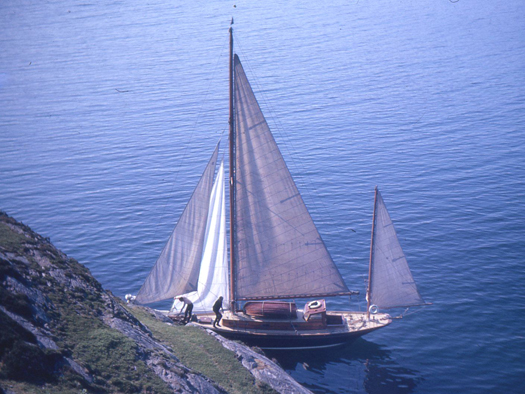 God be with the days.....Ainmara alongside the cliff at Loch Boisdale in June 1963 to collect a bunch of heather for the bowsprit end Photo: W M Nixon
God be with the days.....Ainmara alongside the cliff at Loch Boisdale in June 1963 to collect a bunch of heather for the bowsprit end Photo: W M Nixon
With progress like this, where on earth were we going to stop? Northward she romped, passing Loch Boisdale almost without a thought. Back in 1963 on our first cruise to the Outer Hebrides with Ainmara (when I already thought she was rather an old boat), one fine June morning we were gliding seawards down Loch Boiusdale, and noticed a healthy growth of heather on the nearby cliff. Once you've got north of Ardnmurchan Point, Scotland's Cape Horn, you're entitled to have a bundle of heather on the stemhead or bowsprit end. We hadn't yet got around to this back in 1963, but on that blissful morning we simply came alongside the steep shore, and nipped up the cliff to get the heather. It was Monday June 10th 1963. It was with some relief at the end of June that we noted the exact Golden Jubilee of that magic morning on Monday June 10th 2013 had passed entirely unmarked. You can have enough of Golden Jubilees.
Onward we sailed in August 2012 with gems of lochs like Eynort, Skipport and Uiskkevagh slipping by as this perfect day progressed. Flodday likewise was missed with cavalier disregard, then by Eport the wind was gone, but we motored on to Loch Maddy (48 miles from Castlebay) as we'd never been there before, and it left barely a dozen miles next day to Rodel.
We liked Loch Maddy, it's very Western Isles with the pier in one place and the village in another, and in the morning there was time for an heroic breakfast before heading down the loch in bright sunshine. There was a fine easterly breeze, and out in open water all plain sail was set and we started making impressive knots towards Rodel. I foolishly remarked that this looked like being the best sail of the cruise. Within minutes, it was as if somebody had knocked off a switch. We'd to motor for a while, then a gentle nor'easter had us beating in very leisurely style, and in mid-afternoon we were off Rodel with an hour or so to go to high water.
 While Loch Rodel itself provides only limited shelter, the pool behind Vallay Island is snug
While Loch Rodel itself provides only limited shelter, the pool behind Vallay Island is snug  The tidal entrance looks tricky enough, but it's worth it for the perfect anchorage within
The tidal entrance looks tricky enough, but it's worth it for the perfect anchorage within 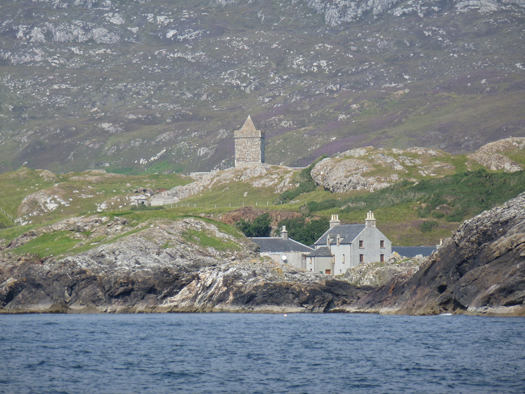 The shoreline begins to take shape, with St Clements Church clear above the hotel at Rodel Photo: W M Nixon
The shoreline begins to take shape, with St Clements Church clear above the hotel at Rodel Photo: W M Nixon
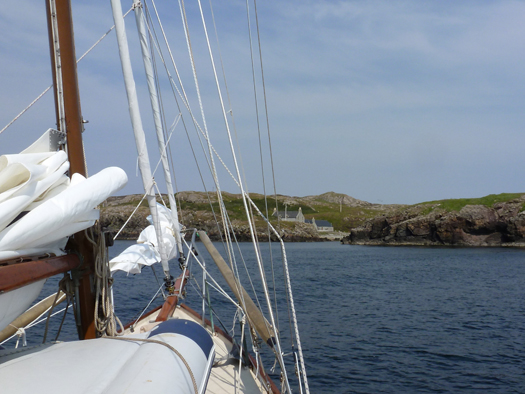 Ainmara is lining up for the Bay Channel into the pool Photo: W M Nixon
Ainmara is lining up for the Bay Channel into the pool Photo: W M Nixon
 The seabed is clearly visible as you pass through the channel close to the port hand marker Photo: W M Nixon
The seabed is clearly visible as you pass through the channel close to the port hand marker Photo: W M Nixon
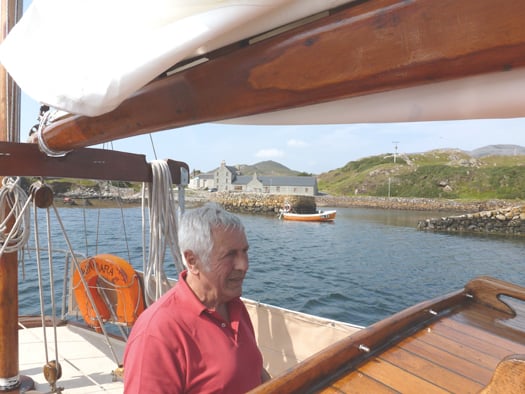 A very relieved skipper as we start to find deeper water in the pool Photo: W M Nixon
A very relieved skipper as we start to find deeper water in the pool Photo: W M Nixon
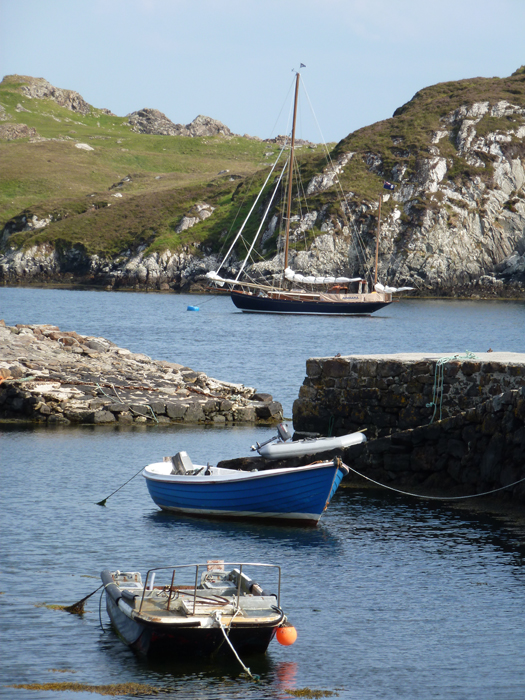 Mission accomplished – Ainmara in Rodel to celebrate her Centenary Photo: W M Nixon
Mission accomplished – Ainmara in Rodel to celebrate her Centenary Photo: W M Nixon
But as tides were neaps, the skipper was a bit nervous as we found our way through the shoal entrance in gentle style. You really do pass very close to the port hand marker. Yet once within the pool, my shipmates saw why I was so keen about this enchanting place, and we happily slowed down to Rodel speed for the rest of the day.
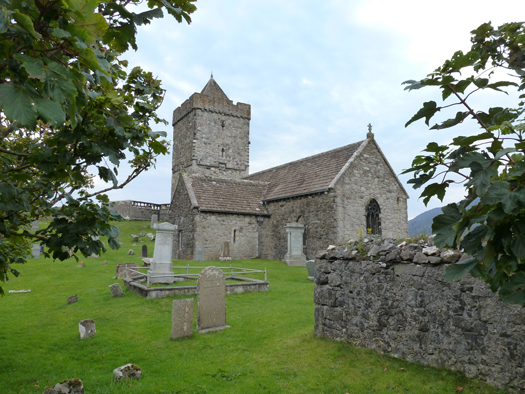 St Clement's Church at Rodel is one of the Outer Hebrides more significant buildings Photo: W M Nixon
St Clement's Church at Rodel is one of the Outer Hebrides more significant buildings Photo: W M Nixon The historic Macleod tomb in St Clement's Photo: W M Nixon
The historic Macleod tomb in St Clement's Photo: W M Nixon
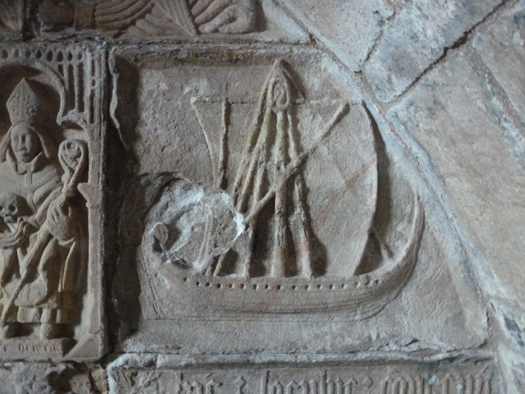 The stone carving on the MacLeod tomb which inspired the Lord of the Isles galley to be built in Greencastle in Donegal Photo: W M Nixon
The stone carving on the MacLeod tomb which inspired the Lord of the Isles galley to be built in Greencastle in Donegal Photo: W M Nixon
Ashore, a visit to St Clements Church fitted the mood perfectly. There is a genuine sense of the past, and of the turbulent history which had once been the lot of this sleepy and now remote place. Down at the restored inn (it's called the Rodel Hotel these days, but for me it will always be the inn), we found the sympathetically-renovated establishment had a new dining room beside a new bar – the old rough bar out the back where we'd started negotiating for the tweed was long gone. And though the Countess of Dunmore's drawing room cum dining room where we'd enjoyed fine linen still exists, it is boarded up. But everything else is very much alive, we were able to have luxurious baths in Jock's Room (thanks Jock) and the setting was perfect with the evening sun still bright on the Centenarian sitting gracefully on her mooring and well visible through the restaurant windows, while the food aspirations were up to speed with a German chef and a friendly and obliging Spanish husband and wife couple front of house.
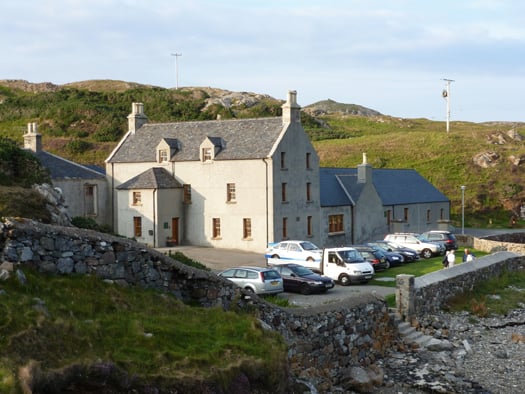 The Rodel Hotel has been restored in a manner which respects its original style. Photo: W M Nixon
The Rodel Hotel has been restored in a manner which respects its original style. Photo: W M Nixon
Appropriately, the skipper had the best of it - he went for the surf'n'turf option which was far from your usual beef and salmon, it was Pabbay venison from the second-last island before St Kilda, combined with Sound of Harris hand-caught scallops. It sounds a bit overpowering, but worked very well, and kept himself in the best of spirits. Denis our third crewman being a sports addict, he was keen to see the Olympics Closing Ceremony on television after dinner, and we were invited to use the Residents' Lounge to do so in comfort. While the lads were settling themselves in there with the coffees and digestifs, I nipped furtively up to the bar to settle the bill - the other two hadn't really believed my "get to Rodel and I'll pay for dinner" proposal - and found what was clearly the man himself running the bar and everything else.
"Would you be our host?" I enquired. "I am indeed," said he, "for my sins I'm the proprietor of this place. Welcome to Rodel. I'm Donald MacDonald".
Such is life. We go all the way, nursing an old boat across hundreds of miles of potentially very turbulent water to Rodel in the Western Isles in order to celebrate her Centenary Feast in the Great Hall of the MacLeods of Harris, only to find it has become a MacDonald's.
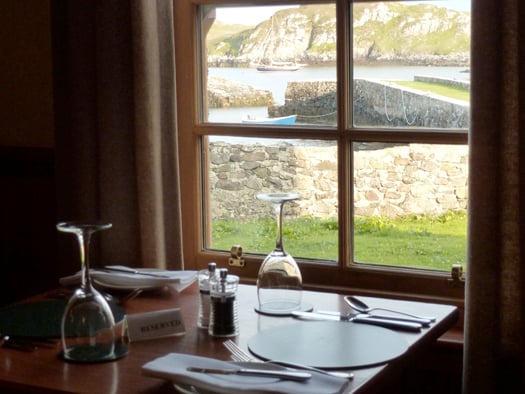 A MacDonald's with a difference – Ainmara serene in the evening sunshine at Poll an Tigh-Mhail, seen from the dining room in the Rodel Hotel. Photo: W M Nixon
A MacDonald's with a difference – Ainmara serene in the evening sunshine at Poll an Tigh-Mhail, seen from the dining room in the Rodel Hotel. Photo: W M Nixon
This article was first published on Afloat on July 27, 2013
The wind is at last from the west, the easterlies of the longest winter in memory have finally relented, and it’s time to be in the west of Ireland and Connemara, time to eavesdrop on two senior boat restorers as they yarn about the challenges they face, and where it might all go writes W M Nixon.
Dickie Gomes of Strangford Lough has been custodian and skipper of the 36ft–Ainmara for more than fifty years. She was designed and built by John B Kearney in Ringsend in Dublin in 1912. The other boat custodian is Paddy Murphy, who once upon a time was Ringsend-based, but he now lives in far Renvyle in northwest Connemara. For many years he has been grappling – both in Dublin and in Connemara - with the challenge of bringing the 1916-built 45ft Isle of Man fishing boat Aigh Vie back to life.
 Even when she was first built in 1916, it was said that Aigh Vie looked more like a yacht than a fishing boat. Photo: W M Nixon
Even when she was first built in 1916, it was said that Aigh Vie looked more like a yacht than a fishing boat. Photo: W M Nixon
Both boats have more stories entwined about them than you’d think possible. John Kearney was a foreman shipwright in Dublin Port, but he wanted to be a yacht designer. And he is so described on his gravestone in Glasnevin in Dublin, his wish fulfilled when he died aged 88.
"John Kearney was a foreman shipwright in Dublin Port, but he wanted to be a yacht designer"
He was one tough little man. So determined was he to design and build Ainmara to prove himself that, after he’d finished his hard day in the Dublin Port workshops, he would return home across the Liffey to Ringsend by the little local ferry, and then set to work every night, building Ainmara without any power tools, with his tasks illuminated by oil lamps. He had the job finished in 18 months.
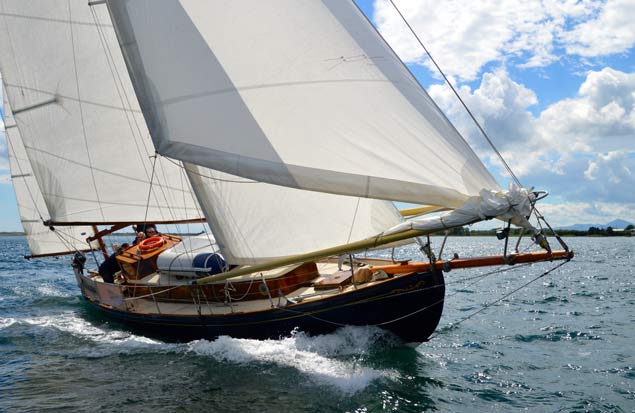 Ainmara in her home waters of Strangford Lough, a 1912-built vessel restored by Dckie Gomes. Photo: Pete Adams
Ainmara in her home waters of Strangford Lough, a 1912-built vessel restored by Dckie Gomes. Photo: Pete Adams
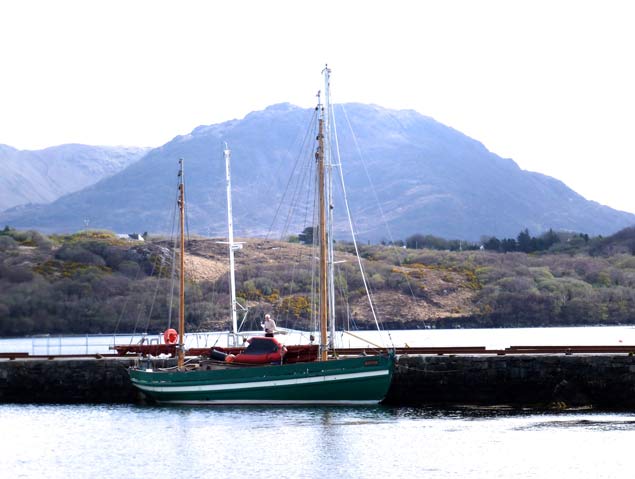 At Letterfrack Pier, Aigh Vie floats to her marks on the morning tide. Photo: W M Nixon
At Letterfrack Pier, Aigh Vie floats to her marks on the morning tide. Photo: W M Nixon
 In the first of the late Spring sunshine, the new spirit blossoms. Photo: W M Nixon
In the first of the late Spring sunshine, the new spirit blossoms. Photo: W M Nixon
Aigh Vie, as we’ve recounted here in Afloat.ie, was the result of an anonymous gift to the captain of an Isle of Man sailing trawler which was owned by others. That trawler – the Wanderer - was the first vessel to reach the stricken ocean liner Lusitania after she’d been hit by torpedoes from a German submarine off the Old Head of Kinsale during the Great War in 1915.
The trawler captain William Ball and his crew were heroic in saving something like 160 lives. And within a year, this mysterious sum of money appeared with a firm of solicitors in his home port of Peel, with the request that Captain Ball commission the local boat-building company to construct his own dreamship. The Aigh Vie was the result.
 The brotherhood. Dickie Gomes of Ainmara and Paddy Murphy of Aigh Vie. Photo: W M Nixon
The brotherhood. Dickie Gomes of Ainmara and Paddy Murphy of Aigh Vie. Photo: W M Nixon
Thanks to the uniquely informative Cormac Lowth, we knew that Paddy Murphy’s recently-launched vessel was berthed at a quay on Ballynakill Harbour. Nevertheless it was one of those moments of purest serendipity when we settled into our place for the weekend while still in the distinctly crisp weather of late April, and there right below the window was Aigh Vie, at Letterfrack Pier glowing in the evening sunlight.
Next day, the two great men, Dickie Gomes and Paddy Murphy, got together without any pre-arrangement. It was something special being in their company. It was five years since last they met, at a time when the Aigh Vie project was still at an early stage. But they’re so precisely on the same wavelength that there was no need for re-introductions - empathy was always present.
 There is still much work to be done in Aigh Vie’s accommodation, but the basic layout is shaping up very well. Photo: W M Nixon
There is still much work to be done in Aigh Vie’s accommodation, but the basic layout is shaping up very well. Photo: W M Nixon
Paddy still has much to do, but it was inspirational nevertheless. He has his own way of doing things, yet beneath all the signs of Work in Progress, there was much evidence that a very attractive layout is developing below, while on deck the concept speaks for itself.
"It is a drumbeat which only a few can hear clearly enough to follow, but those that do sometimes follow it for very many years"
But to understand it all, to grasp the deeper meaning of why people take old boats and work all hours to breathe new life into them, you have to be of a strange brotherhood, a brotherhood which walks and sails to the beat of a different drum. It is a drumbeat which only a few can hear clearly enough to follow, but those that do sometimes follow it for very many years.
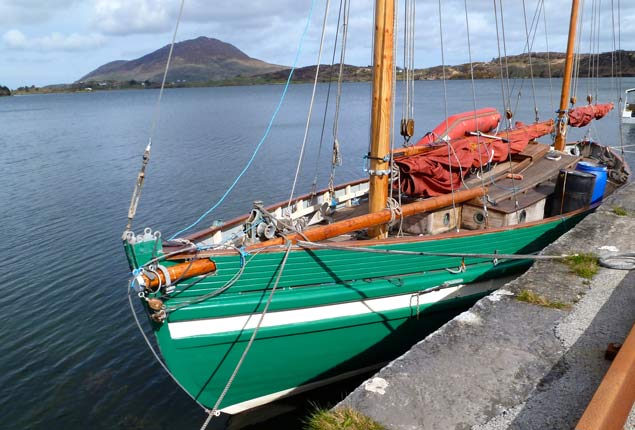 In her new form, Aigh Vie is a handsome vessel. Photo: W M Nixon
In her new form, Aigh Vie is a handsome vessel. Photo: W M Nixon
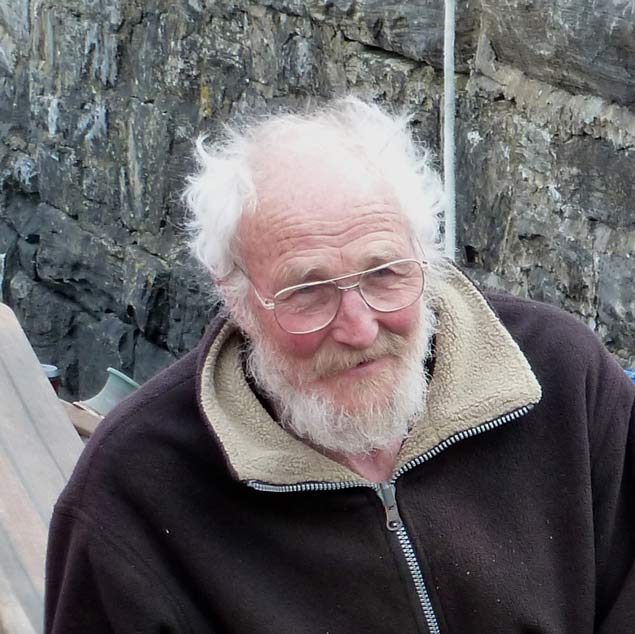 Paddy Murphy of Renvyle, man of many talents. Photo: W M Nixon
Paddy Murphy of Renvyle, man of many talents. Photo: W M Nixon
Ainmara Ballad Video Tells The Story of Classic Yawl
#ainmara – A shanty sung by Jim Uprichard tells the tale of the Dickie Gomes skippered and self-maintained 102-year-old 36ft–yawl Ainmara that has featured regularly on Afloat.ie
The brief youtube video (above) of Dickie Gomes' Ainmara shows clips from a 'reunion' cruise to the Western Isles in July with Ed Wheeler in Witchcraft and Pete Adams, Jesz Fleming, Geordie Lynas, Dave Witherow and his Kiwi friend John 'Two Pies' Dean.
Ireland's Oldest Wooden Boats Aren't Getting Any Younger
#woodenboats – On Midsummer's Day, W M Nixon looks back on the already busy and event-filled Irish season of 2014, and reflects on the extraordinary longevity of some boats, their remarkable variety, and the diverse characters who own them.
When I shipped aboard the former Bristol Channel Pilot cutter Madcap to sail the Old Gaffers Division in Howth Yacht Club's Lambay Race on June 7th, it wasn't the first time I'd been out and about on a boat built in the 1870s. But as most of my experiences on John and Sandra Lefroy's 1873-vintage iron-built classic 58ft Victorian steam yacht Phoenix on Lough Derg took place in the 1970s with the most recent jaunt being way back in 1982, sailing on the Madcap was indeed the first time afloat in a boat built 140 years ago.
It takes an effort to get your head around the most basic notion of such an age. You find yourself reflecting on the delights that still awaited the human race at the time, things that were still far into the remote future in the 20th Century. During the 1870s, industrialisation was still gaining traction, but the very idea of warfare on the industrial scale which was to be experienced in the Great War of 1914-18 was beyond most people's imagination, and way beyond anyone's experience. That said, there were more than enough other ways of experiencing an early death, with a range of particularly unpleasant illnesses which have been largely eliminated today.
Yet it was increasing industrialisation which created the circumstances that enabled both boats to be built. The Bristol Channel Pilot cutters evolved rapidly in the latter half of the 19th Century in order to provide pilots for the more numerous and increasingly large ships which were coming into ports such as Cardiff and Bristol. They reached their peak of performance around 1900, by which time they'd achieved a remarkable stage of development, being fast and able, yet comfortable at sea, and capable of being handled by a very small crew after the pilots had been delivered to incoming vessels. When their working days were over as they were replaced by motorised vessels, they proved ideal as seagoing cruising yachts.
There was nothing work-oriented about the pleasure yacht Phoenix when she was built to the designs of Andrew Horn in Waterford in 1873. Or maybe that's being a bit naïve. After all, she is down as having been built by and for the Malcolmsons of Waterford. They were a remarkable clan who brought many industries to Waterford in the 19th Century, and they created the miniature industrial town of Portlaw westward from the city, off the south bank of the Suir Estuary.
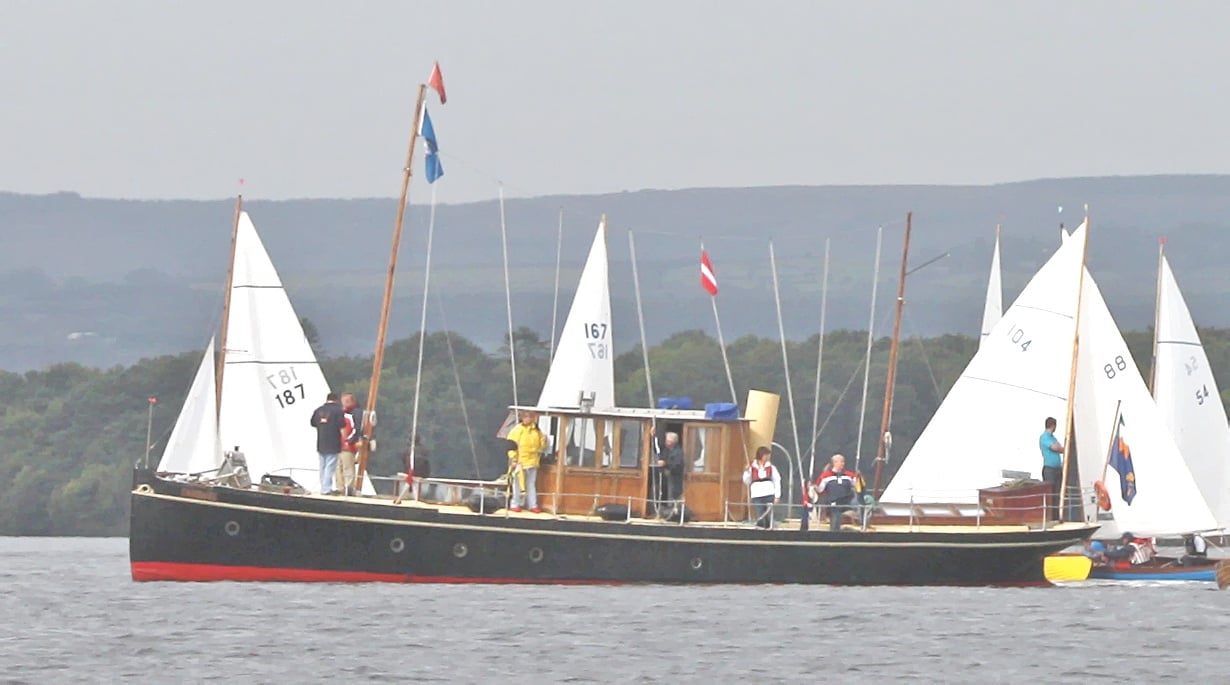
The 58ft Phoenix, iron-built in Waterford in 1873, performing Committee Boat duties at Dromineer for Lough Derg YC. Photo: Gerardine Wisdom
So in building the Phoenix themselves, so to speak, they were creating a subtle advertisement for Waterford expertise, with this new miniature of an ocean liner being constructed in the highly-regarded Lowmoor iron. And she's a powerful statement - this lovely old vessel has lasted much better than many of the Waterford enterprises which outshone her at the time of her building, so much so that if, in Waterford's current recessional woes, they sought something to symbolise what the city is capable of, they would do worse than put some resources the way of the Phoenix for her continuous maintenance.
Five years ago she made a very stylish appearance as the Committee Boat in a classics regatta at Dromineer, and that in turn produced an astonishing photo which included Ian Malcolm's 1898-built Howth 17 Aura. It was the first time a jackyard topsail had been seen on Lough Derg since before the Great War, and all that together with a raft of Shannon One Designs (which date from 1922 onwards) and a fleet of Dublin Bay Water Wags from 1902 onwards meant that the total age of the boat in the photo was pushing towards the 2,000 years mark.

Phoenix and the 1898 Howth 17 Aura (Ian Malcolm) at Dromineer with rafts of Shannon ODs and Water Wags. The combined age of the bots in the photo is well over a thousand years. Photo: Gerardine Wisdom
To be aboard Phoenix is to be transported right back to the 1870s, as she has a beam of only 10.5ft, which on a length of 58.5ft make for one very slim and potent hull. She has long since had her original steam engine replaced with a diesel, and back in 1982 when I was last afloat in her, it was October, and we were the Committee Boat for the annual IYA Helmsmans Championship, raced that year in Shannon One Designs with Dave Cummins of Sutton the winner, crewed by Gordon Maguire.
Being late season, the Phoenix's injectors needed a clean, but as the Race Officers were those perpetual schoolboys Jock Smith and Sam Dix of Malahide, they were delighted by the Phoenix's ability to emit a fine plume of smoke from her funnel at full speed, and after the championship was resolved they tore across the lively waters of Autumnal Lough Derg at full speed while – from another boat - I grabbed some photos which made Phoenix look like a destroyer in action at the Battle of Jutland. One of them subsequently appeared as the cover of Motor Boat & Yachting, and as I seem to have mislaid the colour slides, if anyone has a copy of that particular edition I'd much appreciate a scan of it.
Moving on from the 1873-built Phoenix in 1982 to the 1874-built Madcap in 2014 is quite some saga, but we'll edit it by sticking to events this year revolving around the developing annual Old Gaffer programme in the Irish Sea. Last year Dickie Gomes' 1912-built 36ft John B Kearney yawl Ainmara from Strangford Lough won the inaugural Leinster Trophy race in Dublin Bay which marked the OGA's Golden Jubilee, and she did it despite now being bermuda rigged. But as she was returning to her birthplace in Ringsend for the first time in 90 years, she was treated as an honorary gaffer.
Honour being the theme of things, this meant we were honour-bound to bring her south again to defend the Leinster in 2014, but this was given an added impetus by a plan to link up in Dun Laoghaire with Martin Birch's 1902-built Espanola out of Preston in Lancashire. From 1912 until 1940, the 47ft Espanola was a feature of the Royal Irish YC in Dun Laoghaire, owned by noted sailor Herbert Wright, who in 1929 became the founding Commodore of the Irish Cruising Club when he cruised Espanola with four other yachts to Glengarriff where the ICC was founded on July 13th 1929. The Espanola links, together with the fact that the RIYC is now in partnership with Wicklow Sailing Club in hosting the fleet for the biennial Round Ireland Race, made for a fortuitous combination, as Dickie Gomes of Ainmara was Mr Round Ireland between 1986 and 1993, when he held the open Round Ireland Record and also had been overall winner of the 1988 race.

Espanola as she was in 1929, when Commodore's yacht at the founding of the Irish Cruising Club
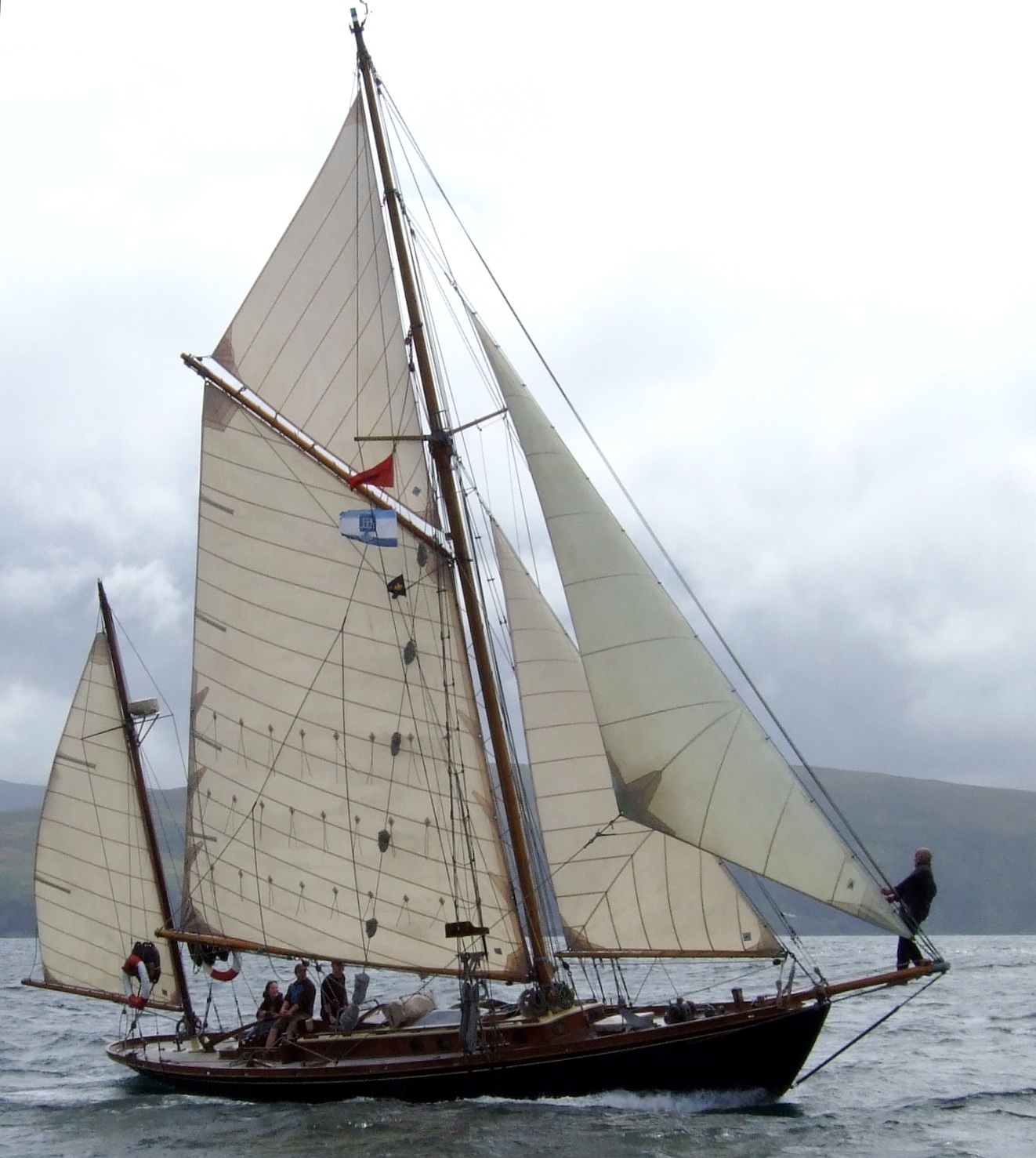
The 1902-built Espanola as she is today
Thus all the stars were in alignment for an historic and convivial meeting of the two old boats at the RIYC on the evening of Friday May 30th, the night before the Leinster Plate race was due to start just round the corner in Scotsmans Bay. But while stars may have been in alignment, ducks failed to get into a row, as Espanola with her exceptional draft of 7ft 6ins failed to get out of Preston over the shallow bar in the one tide which would have suited, on May 16th.
This situation is a useful illustration of the problems the old gaffer people face in keeping the show on the road with limited resources. Martin Birch, having been a lecturer in Lancaster University, had found Preston's little marina an ideal place to keep and maintain Espanola, and the marina in turn regarded the old girl as their pet boat. But Preston is longer a busy commercial port, so the channel has been left to is own devices, and with the huge tides of the Lancashire coast, getting Espanola to sea is quite a challenge as sometimes there's only one day in any month when it can be done.
So there we were, faced with the prospect of Hamlet without the Prince with just ten days to go to the historic gathering at the RIYC. But Jim Horan, affable Commodore of the Royal Irish YC, took it all in his stride and told us to bring Ainmara along anyway, it would be a good excuse for a Friday night party and he was keen to meet the skipper who had made the Round Ireland challenge very much his own 28 years ago.
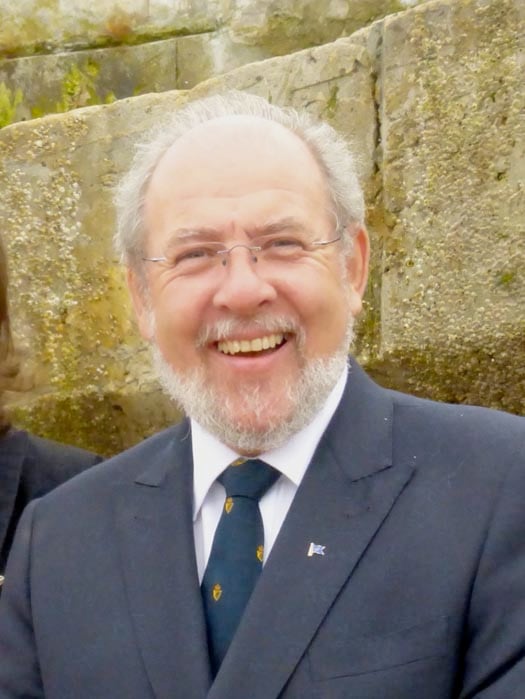
Jim Horan, Commodore of the RIYC, told us to come on and be welcome even though Espanola couldn't make it. Photo: W M Nixon
With the foul weather of mid-May, while Ainmara had got afloat from her winter quarters in a hayshed at the Gomes farm on the Ards peninsula in County Down, further fitting out was difficult in endless rain, and the skipper came down with a massive cold. But then the weather perked up, and he did too, so at lunchtime on Thursday My 29th we headed down Strangford Lough from the Down Cruising Club's former lightship headquarters at Ballydorn to catch the start of the ebb in Strangford Narrows at 1430 hrs.
Progress was good with a light to moderate nor'easter, but Ainmara and her crew (there were four of us – Brian Law, Ed Wheeler and I together with Dickie) have got to the stage where nights at sea are regarded to be the result of bad cruise planning. Yet if we were going to be comfortably in Dun Laoghaire for Friday evening, then only Port Oriel at Clogherhead made sense as an overnight. But Port Oriel, home to some of the best-maintained fishing boats on the coast, can become a very crowded place on a Thursday night.
However, a phone call to the uncrowned king of Clogherhead Aidan Sharkey – whom I'd first met back in the 1980s when our two boats were moored in Seal Hole at Lambay, where he was diving on the nearby 1854 wreck of the Tayleur - ensured there'd be a berth for us, and when we arrived in at sunset there was the man himself to direct us to a corner where we wouldn't inconvenience fishing boats, and moreover had access to a set of proper steps.
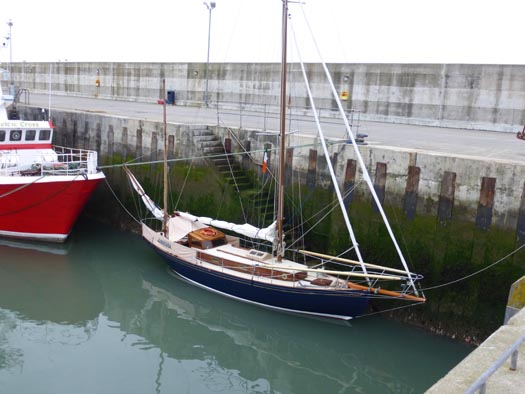
Port Oriel at Clogherhead provided Ainmara wih a handy overnight stop. There was more space available (below) as most of the 30-strong local fleet were away fishing the south coast. Photos: W M Nixon

Aidan's commitment to the maritime life is total. He's of an old Clogherhead fishing family, and he and his late brother Feargal were the backbone of the local beach-launched lifeboat crew. The banter was mighty on board Ainmara, leavened with tales of lifeboat experience which would curl your hair. The laughter through the companionway attracted others board, and soon Sean the razor clam man (all of his catches go straight to China) was in the hatchway with glass in hand, and when we asked where we might get a new deck scrub first thing in the morning as somehow the ship's own one had gone AWOL, Sean said not to worry, he'd throw one on board, and we could just leave it on the big fishing boat beside us as we left next day.
Ashore, I went up to Aidan's house in the village as he'd said he'd something to show me, which was an understatement. He was into the diving much earlier than most, thus when he got to wrecks which today are known to everyone, there were still intact bits of the cargo to be salvaged. Most east coast divers have fragments of chinaware, pottery and other artefacts from the Tayleur, but Sean had so many complete pieces, together with many other items of special antique value from other wrecks mostly in Donegal, that he would be well able to provide complete afternoon tea for the entire choir, all served on 1840s china. But it wasn't tea I got in the Sharkey household, it was Aidan's present of a large bag of fresh crab claws, and a selection of his own-cured salmon – smoked and gravid lax both – which sustained us through the next day's sail.
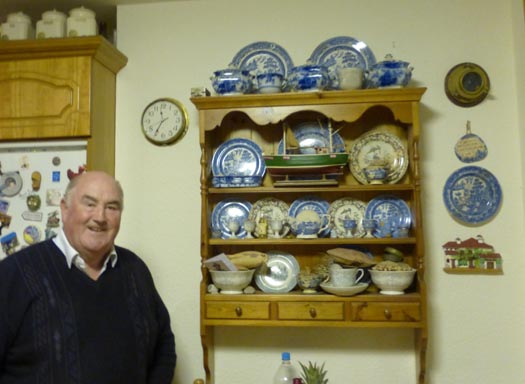
Aidan Sharkey of Clogherhead with some of his remarkable collection of salvaged chinaware. Photo: W M Nixon

The sort of sailing cruising folk dream of. Ainmara shaping up nicely to take the first of the fair tide through the islands at Skerries. Photo: W M Nixon
The morning brought the welcome gift of a decent little sunny east to nor'east breeze, and a lovely beam reach all the way down to Dublin Bay, with the south-going tide caught to perfection at the Skerries islands (and yes, I know it's superfluous to talk of the "Skerries islands", but that's what they're called to differentiate them from the Skerries off Holyhead).
Anyone who was involved in last weekend's ICRA Nationals at the Royal Irish YC will know how this premier club can lay on the welcome with effortless style. In the last weekend of May, Ainmara and her crew had the Royal Irish treatment all to themselves. Sailing Manager Mark McGibney ushered us to the prime berth right at the club where we found ourselves in a miniature maritime museum, with the Quarter Tonner Quest close astern (she was to become the ICRA National Champion a fortnight later), while just across the way was the S&S 36 Sarnia – back in 1966, the Sisk family set Irish sailing alight by bringing this very up-to-the-minute fin-and-skeg fibreglass boat back from builders Cantiere Benello in Italy, where they'd started series production on this ground-breaking Olin Stephens design before the same hull shape became better known as the Swan 36 built by Nautor in Finland.
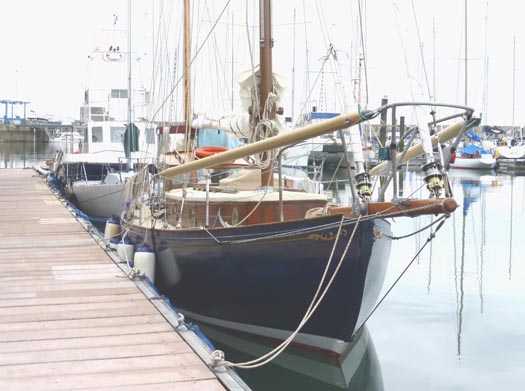
"Maritime museum" at the Royal Irish YC. Ainmara (built Ringsend 1912) with the 1987 Quarter Tonner Quest astern, and the 1966-built S&S 36 Sarnia across the way in her marina berth. Photo: W M Nixon
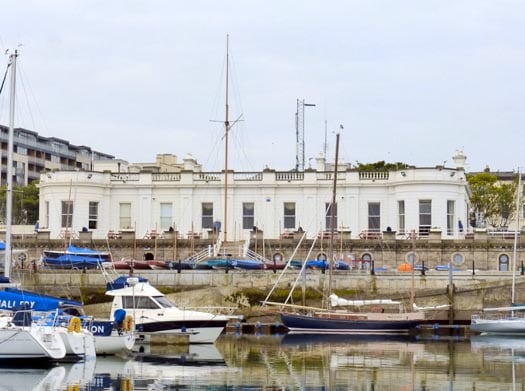
It has to be one of the best berths in the world. Ainmara at the RIYC – it's early morning, and the flags aren't yet hoisted. Photo: W M Nixon
The hospitality flowed seamlessly as the late afternoon graduated into evening and then velvet night. Ainmara is an extraordinarily effective calling card, and the stream of entertaining visitors brought laughter aboard before the Commodore moved us all up to the clubhouse and a fine supper and much chat with Michael O'Leary, one of the most visionary minds in Irish sailing, and his wife Kate and her people with tales of how she and longtime friend Clare Hogan are in the thick of things in the very healthy Water Wag class.
The RIYC took all this in its stride despite the fact that there was a big wedding going in the clubhouse at the same time, but it all went so smoothly that at one stage Ainmara's crew found themselves being invited to join in the wedding celebrations. However, we demurred because we were athletes in training for the Leinster Trophy next day, yet nevertheless certain key players in the wedding got themselves aboard Ainmara at a very late hour.
The plan for Saturday had been changed, but we were right up to speed with this as Denis Aylmer, the RIYC's key man in the OGA, had told us over a convivial pint that the likelihood of light winds had meant that Race Officer John Alvey had moved the scene of the action from Scotsmans Bay to a more compact race area close off the entrance to Dublin Port. It was all grist to our mill, as we could make an early morning departure and head up to Poolbeg Y & BC across a mirror-like bay, lining up the crew to salute the North Bank Lighthouse in the River Liffey, as it's something of a memorial to John B Kearney, whose day job was in the engineering department in Dublin Port and docks. With his original lighthouse, he pioneering a technique of screwing the piles into the seabed. You'd have thought an air of reverence would prevail, but with Ainmara's crew of anarchists, straight faces could only be maintained for about 12 seconds.
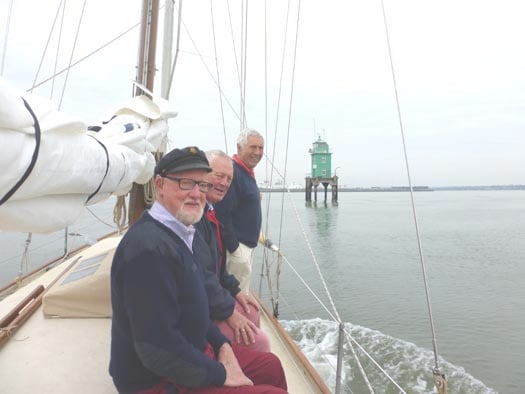
Trying to look appropriately reverential. Ed Wheeler, Brian Law and Dickie Gomes approaching Dublin Port's North Bank Lighthouse on which John B Kearney pioneered the use of screw piles. Photo: W M Nixon

"We're only here for the breakfast". Katy O'Connor's excellent catering in Poolbeg Y & BC is deservedly popular among visiting crews. Photo: W M Nixon
While we wanted to be well on time for the pre-race briefing, the main reason for getting promptly to Poolbeg was to take full advantage of Katy O'Connor's legendary breakfast at the club, and we put away enough calories to keep us going all day. At the briefing, John Alvey told us the committee were concerned that the very varied fleet – everything from Ainmara to the big Naomh Cronan, a superb Clondalkin-built re-creation of a Galway Hooker – included some boats which, in the light airs expected, could be out on the bay until nightfall.
So the plan was for a short race taking in several marks so that it could be finished at the end of any leg. But by the time we got down to Dublin Bay, it was crisp blue with a smart little sea breeze filling in to give sailing conditions which suited Ainmara to perfection, yet some of the heavier gaffers were still lumbering slowly about in what to them was a light wind.
They may have been lumbering about, but several were very determined to make a sharp start right on the committee boat. Anyone accustomed to quick-turning and fast-accelerating modern boats will find a fleet of traditional and classic gaffers a real education. They take time to get moving, they take for ever to stop, you point them a long way out, and their bowsprits – "dock probes" as marina managers call them – seem intent on skewering everyone else.
But while our skipper may pretend to be just an old cruising man these days, his racing blood was up. We set ourselves to sweep into what we hoped would be a gap starting to appear at the committee boat seconds after the start signal. We consoled ourselves with the thought that in extremis, we might just manage to shoot head to wind leaving the committee boat to port, ruining our start perhaps, but preserving the Ainmara intact.
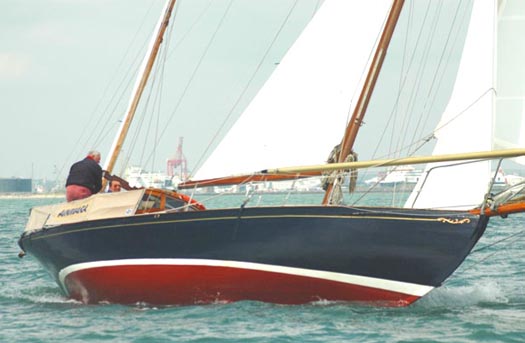
"Go for it, and let's hope there's a gap when we get there..." Ainmara starts to build speed towards her start in the Leinster Trophy Race 2014 . Photo: Gill Mills
So she was set at it, despite attempts to slow her a bit the speed built up, but as quickly as I'm telling this the gap started to appear and she zapped into it and just managed to keep her wind clear on Sean Walsh's remarkably fast Heard 28 Tir na nOg and Denis Aylmer's Mona. Now we had to find the DBSC marks in the right sequence, but Ed was on top of it feeding co-ordinates and giving out courses, we found that with a bit of luck we might just lay the first mark close hauled, and though Tir na nOg – whose waterline length is much the same as Ainmara's – hung in very well, he'd to tack for the mark while we scraped by it, so after that it was up jib tops'l and making hay.
But though we took line honours, we felt certain Tir na nOg would win on corrected time, as a Heard 28 sailed as well as she is can be one very potent performer, and Sean seemd to be still right on our stern at the finish. The results wouldn't be announced until Monday evening, so that Saturday afternoon we wandered back upriver to Poolbeg in sunshine so powerful that an afternoon zizz was your only man, and then we emerged on deck to find that others were arriving in port, with one of the the Welsh visitors, the engine-less Happy Quest from Milford Haven, making a copy-book job of berthing under sail, and then all was alive with the Howth Seventeens arriving in from their home port after a very close-fought passage race which had been narrowly won by Conor Turvey sailing Isobel.

Happy Quest from southwest Wales lives up to her name with a successful berthing under sail only at Poolbeg. Photo: W M Nixon
The Seventeens were there to put on a display race next day (Sunday) in the Liffey as part of the three day Dublin Port Riverfest over the Bank Holiday weekend. Inevitably for those of us who took part in the first one in 2013 when the OGA Golden Jubilee was top of the bill, there wasn't quite the same buzz, but first-timers watching aboard the restaurant ship Cill Airne assured us they found it very exciting indeed, and were especially impressed by the waterborne ballet of the two big harbour tugs Shackleton and Beaufort, while the funfairs and entertainment shows along the quays really did provide something for everything.
Once again the very sight of the Seventeens – which we in Howth tend to take for granted – was fascinating in the city setting. Though the promise of a decent breeze evaporated, Race Officer Harry Gallagher managed to get enough in the way of results to declare Peter Courtney with Oonagh the winner, an appropriate result for an historic class making a show performance, as the Courtneys have been involved with the Howth Seventeens since 1907.
I watched it all from an appropriate setting, aboard the Dutch Tall Ship Morgenster, a handsome 150ft brig which should be required visiting for anyone promoting the idea of a new Tall Ship for Ireland. For the Morgenster – which was re-configured as a sailing ship in 2009 – is run as a commercial venture, and can pay her way through being the right size to be a business proposition, helped by being based in the Netherlands. Thus she has a vast continental catchment area nearby to attract trainees of all ages and abilities who are prepared to pay enough for berths to keep the show efficiently on the road. There are several Dutch-based tall ships run in the same way, and the message is that if you're going to make a go of it commercially, you have to have a large enough and readily-accessed market to make it viable, and you need a boat big enough to carry sufficient trainees relative to the size of the ship – 36 in Morgenster's case – to balance the books.
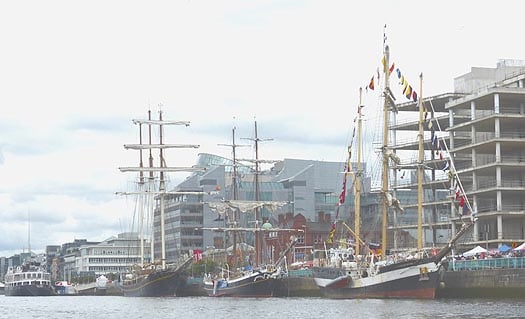
Tall ships in the Liffey, with the commercially-run 150ft sail training big Morgenster at centre. Photo: W M Nixon
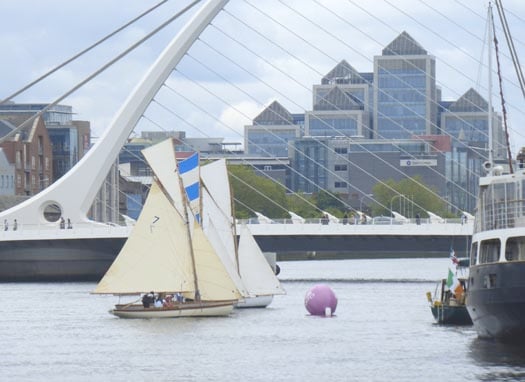
Sails and the city – Howth 17s at the Sam Beckett bridge Photo: W M Nixon
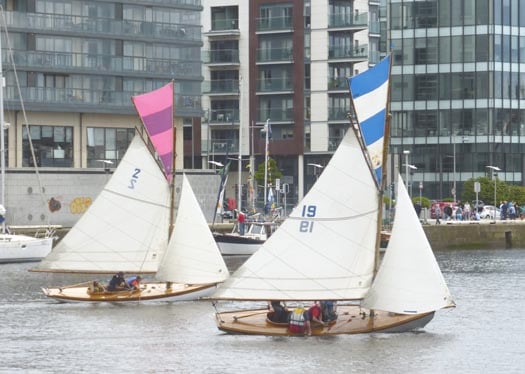
There was just enough wind for the first race for the Howth 17s to show what they could do in the Liffey if the breeze held up. Photo: W M Nixon
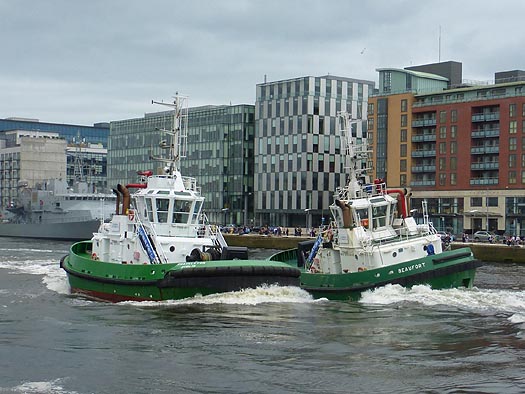
The Dublin Port tugs have awesome power to deploy in their waterborne "ballet" Photo: W M Nixon
But enough of solemnity. We went downriver again for farewells at Poolbeg, and then away across Dublin Bay and round the Baily for a seafood feast in Howth at the new place Crabby Jo's, and a handy overnight stop before using a good westerly next morning to give us a push towards Ardglass where we needs must stop, as the tides into Strangford Lough are a door slammed shut every six hours. But as ever, Ardglass's convenient and friendly little marina provided the perfect decompression chamber, and up in Mulherron's the crack was mighty with the crew of the famous restored Manx longliner Master Frank, just the two of them with skipper Joe Pennington - aka The Rat – being crewed by a psychiatrist who claimed to be strictly on holiday, but we did wonder, as any gathering of Old Gaffers is better than a wardful of nutters.
Ainmara's mini-voyage concluded next day with a text message from Dublin to tell us we'd retained the Leinster Trophy, which surprised us, and then with an idyllic sail in a sunny sou'wester, everything set to the jib tops'l, and all sail carried right through The Narrows, across Strangford Lough and thorough Ringhaddy Sound, and on across a blue sea among green islands past tree covered shores until we handed the sails just off the entrance to Down Cruising Club's isle-girt outer anchorage immediately south of Mahee Island, in a little sheltered area which has somehow acquired the unlovely name of Pongo Bay.

Home again. Ainmara back on her mooring in Strangford Lough, with Brian Law's classic yawl Twilight astern. Photo: W M Nixon
There, Ainmara is securely moored close to Brian Law's own cruising boat, the beautifully restored classic Lion Class yawl Twilight, designed by Arthur Robb. Like Dickie Gomes, Brian does all his own boatwork in a hayshed beside the house. So closely intertwined are their interests that they readily crew for each other, and of course the exchange of information and assistance and re-fit ideas is continuous.
And there's one further fact about these guys which may be of interest to other cruising crews. Aboard Ainmara during the three seasons in which I've cruised on her since she was restored for her Centenary in 1912, there's no kitty to cover expenses. There's an underlying feeling that as the skipper provides the boat, the crew owe him on a permanent basis. Thus if we get into a port and there's a choice between a comfortable marina berth or hanging off a quay wall, the crew will simply slip away and discreetly pay for a marina berth, and then tell the skipper it's a done deal.
Equally, when ashore for a meal, one of the crew will usually sidle off and pay for everyone when no-one else is looking. But if the skipper thinks the day has gone particularly well, you'll sometimes find he's paid for it all himself, As for getting diesel, whoever is carrying the cans will pay for it himself. Then too, when stores are required, it's covered by whoever goes to get them. It all sounds like an accountant's nightmare, yet so far, somehow at the end of the cruise everyone is content with the feeling that it has all balanced out, and as it has worked well for three years and longer, the attitude is that if it ain't broke, then don't try and fix it.
It had been hoped that Ainmara could stay on in the Dublin area for a week to do the Howth YC's Lambay Race in the Old Gaffers division on June 7th, as she won it in 1921. However, there was too much work still to be done to get her completely ready for a busy cruise programme coming rapidly down the line. But as she'll have to be back next year to defend the Leinster Trophy again, who knows but the double event might be done in 2015. As it was, her need for further fitting-out nearer to home was the saving of me, as a mighy temptation arose. The ancient Madcap from the north had stayed on in Dublin Bay, and was doing the Lambay Race with other old gaffers. The word on the waterfront is that Madcap may well be sold to France to be the centrepiece of a maritime museum in La Rochelle. So the Lambay Race might well be the last chance to sail on a 140-year-old boat. A place was secured on board.

The gaffers gather......Tir na nOg, Madcap and Naomh Cronan on misty morning in Howth before the Lambay Race. Photo: W M Nixon
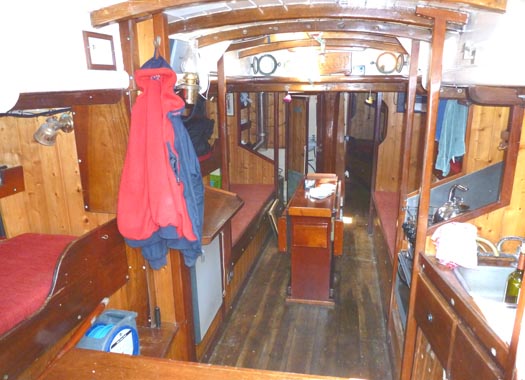
Madcap's sensible accommodation (above and below) reflects the seagoing needs of the pilots for whom she was built140 years ago. Photo: W M Nixon
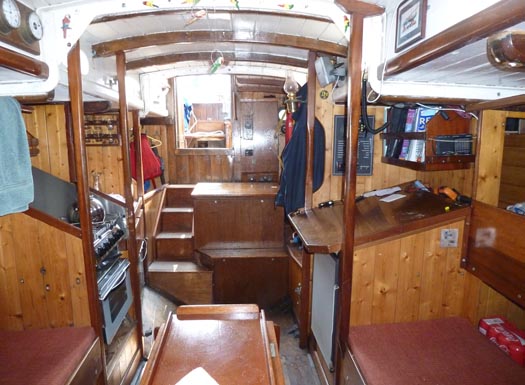
Madcap's owner for more than twenty years now has been Adrian "Stu" Spence, a rugged Belfast barrister who has the essential determination to keep such an ancient boat going. And going places too – he has been to Greenland and several times to Spain and Brittany, and has brought his old cutter through many a problem to log an impressive voyaging record.
If you have a boat of this age, your motto is: When God made time, he made a lot of it. Thus although the Old Gaffer's division was due to start at 1135, five minutes after the Howth Seventeens had set off through Howth Sound to sail the traditional Lambay course leaving Ireland's Eye to starboard and Lambay to port in order to celebrate the centenary of the Lynch family's Howth 17 Echo, it was pushing 1140 by the time we mde our leisurely debut to follow other other gaffers, which had Sean Walsh's keenly-sailed Tir na nOg soon disappearing into the misty asterly, followed by the Galway hooker Naomh Cronan helmed by the great Paddy Murphy of Renvyle, the Cornish crabber Alice (Mark Lynch) and then Madcp in her own good time.
With Northern Ireland Old Gaffers Association President Peter Chambers on the helm, Madcap settled gently into her stride, showing that she needs very little steering – she'll maintain a straight line for miles without the wheel being touched or secured in a any way. It's an oddly soothing characteristic, just the thing to calm a man down after a hectic week in the High Court, and she soon was making her own best speed with a bit of bite now in the breeze, putting Alice astern and keeping Naomh Cronan handily in touch.

"Is it always this foggy off Howth?" Stu Spence and Peter Chambers with he visibility closing in during the Lambay Race. Photo: W M Nixon
The mist became fog, but as ever it was difficult to tell just how thick it was until we suddenly found ourselves surrounded by wraiths in the gloom. It was Class 0 racing towards Lambay, and overtaking us just feet away, giving dramatic close-ups of some of the most likeable boats on the East Coast, with Stephen O'Flaherty's Spirit 54 Soufriere pacing it with Chris Hourican's First 47.7 Pretty Polly and the Tyrrell family from Arklow with their handsome J/122 Aquelina.
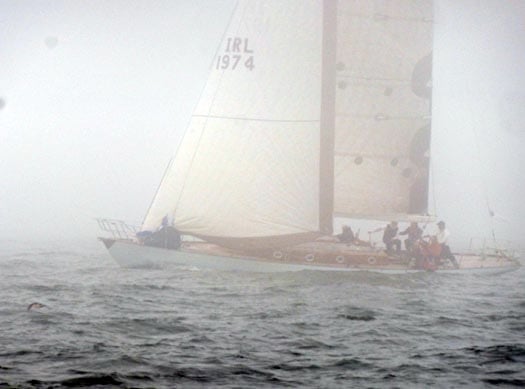
Do not adjust your sets, it really was this foggy for a while. Stephen O'Flaherty's Spirit 54 Soufriere in the fog during the Lambay Race Photo: W M Nixon

Chris Hourican's First 47.7 Pretty Polly in close-up Photo: W M Nixon
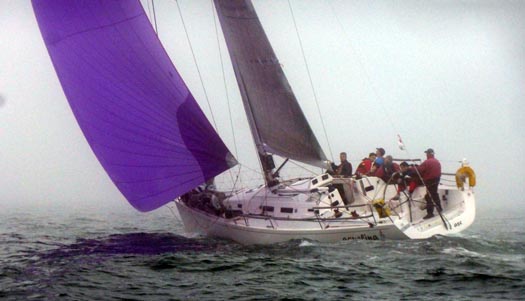
The Tyrrell family's J/122 Aquelina looking her best as she slices through the fog. Photo: W M Nixon
The fog was lifting as we got to the island with boats everywhere – the gaffermen were most impressed. Naomh Croanan had been overtaken, and Peter found us the perfect track along the flukey north side of Lambay, with Madcap effortlessly sliding over the smooth sea on a dead run and apparently consolidating her position.
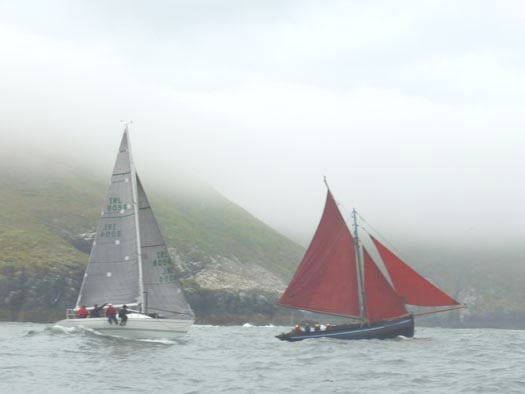
The fog start to lift. Dave Cullen's Half Tonner King One and te Naomh Cronan pproaching the east point of Lambay. Photo: W M Nixon
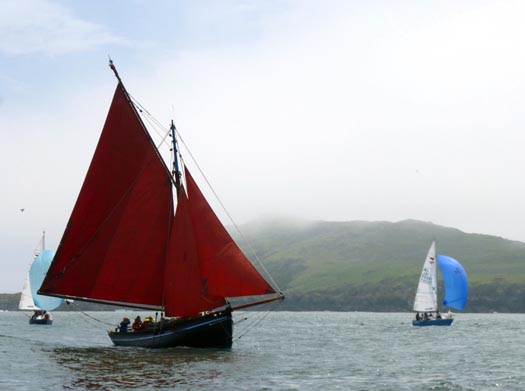
It could be Connemara...., .Naomh Cronan and two Puppeteer 22s off the north coast of Lambay Photo: W M Nixon

The long haul to the finish, the sun is out, and the breeze is beginning to develop enough power to suit Madcap. Photo: W M Nixon
But that was only until we started to head south back to the finish in Howth Sound. The Bermudan boats could lay it, so could the Seventeens, but poor old Madcap was even outpointed by Naomh Cronan, which Paddy Murphy very skilfully kept inside the line of foul tide in Lambay Sound and began to nibble at our lead, while we sagged to lee.
The sun was out, the sailing was lovely, we were surrounded by bustling classes of Puppeteer 22s and Ruffians 23s, and I suggested that a bit more tension in the jib luff, might do the trick, only to be told that as the bowsprit was no more than a liberated telegraph pole, it wasn't really up to the loads which would be put on it by trying to maximise the performance of a 22-ton boat, and nobody wanted splinters flying every which way aboard a boat where the mainboom looked to weigh at least half a ton.
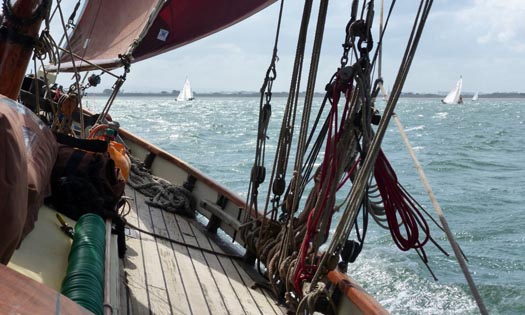
A bite to the breeze, with little boats everywhere – and all of them on starboard. Photo: W M Nixon

The Dun Laoghaire Ruffian 23s made a weekend of it for the Lambay Race, coming over on the Friday night, partying mightily, and then going out to race on Saturday in a rising breeze. Photo: W M Nixon
As it is the loads becme quite something as the breeze freshened sunny and squally down the north flank of the hjill of Howth. By the time we made it across the line, Madcap was going well on smooth water under just mainsail and staysail. But though Naomh Cronan was still ahead and rightly delighted with themselves at getting a good second, it was Tir na nOg which had been in race of her own. Yet as Sean Walsh reported with astonishment, he hadn't been able to get among the slippy little Howth 17s, where John Curley and Marcus Lynch had a good win with Rita, Howth Seventeen No. 1.
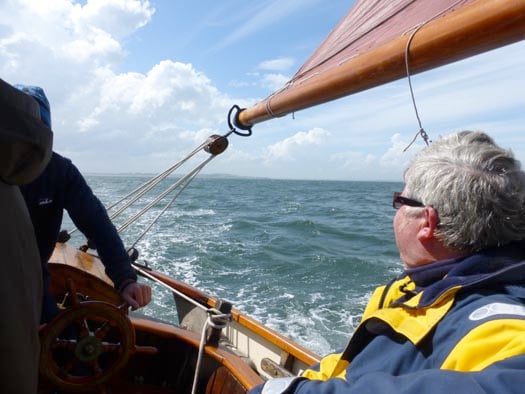
Finally there was enough breeze for Madcap's wake to stretch satisfyingly astern while she could point better with the jib brought in, but Naomh Cronan still finished ahead to take second prize. Photo: W M Nixon

The mighty helmsman of Renvyle. Paddy Murphy (left) steered Naomh Cronan to an excellent performance in the Lambay Race 2014. With him is DBOGA Hon Sec Gerry Murtagh with a trophy he won racing round Lambay in 1986. Photo: W M Nixon
It seemed an Old Gaffers Classic Lambay Race had been inaugurated, and Sean Walsh, international President of the OGA, was most appropriately the first winner. It was something to celebrate, and it duly was, in the sunshine at Howth YC. But in time, I had to take myself away and go for a long walk with the little dog along the beach. For when you've been sailing on a 140-year-old boat, there's a need to ponder the passing years, and this crazy sport of ours in which museum pieces are part of the action.
Sail Away From It All to The Western Isles, the Outer Hebrides
#hebrides – August is almost upon us. The heat has been fierce, and the summer season has been busy. Despite some blips in the weather, civilised folk will be thinking of sailing away from it all for a while. North and west perhaps, in the hope of finding uncrowded and beautiful places which may be cooler. The Western Isles, the Outer Hebrides, are calling us away.
Certainly they did so in August last year, but not for reasons of heat. On the contrary, the jetstream lay persistently along Ireland's south coast, and July's weather here was appalling. But the word came back that up in the Hebrides, they were already thinking of water shortages as the sun shone on and on.
We had contemplated taking the 1912-built 36ft Kearney yawl Ainmara to southwest Ireland for her Centenary cruise. But as owner Dickie Gomes is an enthusiast for the west coast of Scotland in any case, it was no contest. Twelve days in mid-August were allocated to celebrating the old girl's emergence from a 27-year restoration with some Hebridean island-hopping. And I became so taken with the idea that I made an offer that if we could get to the remote little pool of Rodel at the southern tip of Harris, I'd stand my two shipmates the Centenary Dinner at the inn beside that enchanted anchorage.
Rodel is a real honey-trap, as you need a good rise of the tide to get through the drying channel into the deep pool, and there you are - whether you like it or not - until the tide returns. But it's no hardship, as the place is beautiful, the inn is welcoming, and for a thoughtful insight into times past in the Western Isles, just up the road is the restored late mediaeval church of St Clement, complete with the famous MacLeod tomb with its carving of a sailing vessel, the inspiration for Wallace Clark's building of the Lord of the Isles galley with which he voyaged from Connacht to Stornoway.
 The Centenarian on a silver sea – after a restoration lasting 27 years, Ainmara deserved to spend her hundredth birthday at a very special place Photo: W M Nixon
The Centenarian on a silver sea – after a restoration lasting 27 years, Ainmara deserved to spend her hundredth birthday at a very special place Photo: W M Nixon
 The cruise objective – Rodel is exactly in the middle of the long necklace of the Outer Hebrides
The cruise objective – Rodel is exactly in the middle of the long necklace of the Outer Hebrides
It's the sort of place that everyone thinks they are the first to discover, and my own first discovery of Rodel came in 1977 when we sailed in aboard Johnny Roche's 26ft South Coast OD Safina. The party in the inn was mighty, and dawn was already hinting when we struck a deal in the old kitchen to buy a bolt of Harris tweed, woven within sight of the anchorage. We sailed home with the tweed in a sailbag in the foc's'le, and two of the crew then commissioned that great Dublin tailor Jack O'Rourke (father of current Mermaid National Champion Jonathan O'Rourke) to make them up a couple of suits from our seafaring cloth.
Although they both were of much the same age, one was an old fogey from birth, while the other was a permanently young trendy. So when Jack finally produced the suits to their two very different and clearly defined specifications, it took a real effort to realize that both outfits were cut from the same piece of tweed, as one was a very sharp and fashionable bit of work, while the other had all the timeless style of a sack of potatoes.
Next time back to Rodel was six years later with my own Hustler 30 Turtle, and some of those good folk of Rodel with whom we'd partied in '77 had since gone to the great weaving mill in the sky, while the inn was running out of steam. It still clung to some semblance of gentility with immaculate table linen, but portions for dinner were of such modest size that we simply had two dinners apiece, one after the other.
That was all of thirty years ago, and since then the word was the inn had closed down completely. But a few years ago there was a welcome whisper of a restoration under completely new ownership. So when Ainmara's centenary came up the agenda, it seemed the perfect setting for a mid-cruise Centenary Dinner, and we departed from Ballycastle towards the sunny Hebrides with this interesting cruise objective in mind, while astern the Irish coast continued to lie under cloud.
Despite his impressive record of international long distance offshore racing, these days Dickie Gomes takes care to avoid unnecessary nights at sea, so our progress towards Rodel was gentle yet effective, hopping our way via Port Ellen and Ardbeg in Islay, then on to Scalasaig in Colonsay, and then out to Tiree to be nicely placed for the passage across the Sea of the Hebrides to Barra.
There'd been only one other yacht in Gott Bay in Tiree when we arrived, but there were half a dozen getting under way in leisurely style that morning. Ainmara was the only boat to head west out through Gunna Sound between Tiree and Coll into the Sea of the Hebrides, shaping our course for Barra and motoring gently through a large shoal of basking sharks going about their leisurely work. There was a strengthening breeze from the northeast and the soft grey cloud cover was melting away. It may have been three days already since leaving Ballycastle, but coming out through Gunna Sound gave a special feeling of the cruise really getting under way, and it settled into a perfect 40 mile passage, beam reaching in sunshine with everything set to the jib tops'l on its first outing, and the distinctive peaks of the southern outliers of the Western Isles starting to rise above the horizon while still thirty miles ahead.
 First port in the Outer Hebrides - Castlebay in Barra revelled in the August sunshine Photo: W M Nixon
First port in the Outer Hebrides - Castlebay in Barra revelled in the August sunshine Photo: W M Nixon
Castlebay basked in the sun, the heat was solid, and the tarmac on the quayside road was soft in the sun. At first we were in solitary splendour on the visitors mooring nearest Kisimul Castle, that ancient fortress of the MacNeils, but some other boats came in later in the evening. Up in the cool of the pub, glad to be out of the fierce sun, our gallant skipper met so many interesting folk that we were too late to get a booking at the funky little Café Kisimul on the quay, but had a reasonable meal in the hotel above the boat and retired aboard in a state of enchantment at being in the Outer Isles.
The morning brought a crisp easterly and hazy sunshine, so we were away early to make northing through the Sea of the Hebrides. We'd thought to drop into Eriskay for a lunch break, but the sailing was just too good, this was what we'd come for, we just kept going, and began to think that in a day or two we might even get to Rodel. Once the southeasterly headland on South Uist was astern, the sheets were eased and Ainmara settled into her stride with the jib tops'l pulling well, and the ancient mizzen staysail in its Killkenny colours of black and gold making its first appearance after a very long time in storage.
 This is what we came for – glorious sailing in the Sea of the Hebrides with the ancient mizzen staysail (in the Kilkenny colours) pulling well. Photo: W M Nixon
This is what we came for – glorious sailing in the Sea of the Hebrides with the ancient mizzen staysail (in the Kilkenny colours) pulling well. Photo: W M Nixon
 God be with the days.....Ainmara alongside the cliff at Loch Boisdale in June 1963 to collect a bunch of heather for the bowsprit end Photo: W M Nixon
God be with the days.....Ainmara alongside the cliff at Loch Boisdale in June 1963 to collect a bunch of heather for the bowsprit end Photo: W M Nixon
With progress like this, where on earth were we going to stop? Northward she romped, passing Loch Boisdale almost without a thought. Back in 1963 on our first cruise to the Outer Hebrides with Ainmara (when I already thought she was rather an old boat), one fine June morning we were gliding seawards down Loch Boiusdale, and noticed a healthy growth of heather on the nearby cliff. Once you've got north of Ardnmurchan Point, Scotland's Cape Horn, you're entitled to have a bundle of heather on the stemhead or bowsprit end. We hadn't yet got around to this back in 1963, but on that blissful morning we simply came alongside the steep shore, and nipped up the cliff to get the heather. It was Monday June 10th 1963. It was with some relief at the end of June that we noted the exact Golden Jubilee of that magic morning on Monday June 10th 2013 had passed entirely unmarked. You can have enough of Golden Jubilees.
Onward we sailed in August 2012 with gems of lochs like Eynort, Skipport and Uiskkevagh slipping by as this perfect day progressed. Flodday likewise was missed with cavalier disregard, then by Eport the wind was gone, but we motored on to Loch Maddy (48 miles from Castlebay) as we'd never been there before, and it left barely a dozen miles next day to Rodel.
We liked Loch Maddy, it's very Western Isles with the pier in one place and the village in another, and in the morning there was time for an heroic breakfast before heading down the loch in bright sunshine. There was a fine easterly breeze, and out in open water all plain sail was set and we started making impressive knots towards Rodel. I foolishly remarked that this looked like being the best sail of the cruise. Within minutes, it was as if somebody had knocked off a switch. We'd to motor for a while, then a gentle nor'easter had us beating in very leisurely style, and in mid-afternoon we were off Rodel with an hour or so to go to high water.
 While Loch Rodel itself provides only limited shelter, the pool behind Vallay Island is snug
While Loch Rodel itself provides only limited shelter, the pool behind Vallay Island is snug  The tidal entrance looks tricky enough, but it's worth it for the perfect anchorage within
The tidal entrance looks tricky enough, but it's worth it for the perfect anchorage within  The shoreline begins to take shape, with St Clements Church clear above the hotel at Rodel Photo: W M Nixon
The shoreline begins to take shape, with St Clements Church clear above the hotel at Rodel Photo: W M Nixon
 Ainmara is lining up for the Bay Channel into the pool Photo: W M Nixon
Ainmara is lining up for the Bay Channel into the pool Photo: W M Nixon
 The seabed is clearly visible as you pass through the channel close to the port hand marker Photo: W M Nixon
The seabed is clearly visible as you pass through the channel close to the port hand marker Photo: W M Nixon
 A very relieved skipper as we start to find deeper water in the pool Photo: W M Nixon
A very relieved skipper as we start to find deeper water in the pool Photo: W M Nixon
 Mission accomplished – Ainmara in Rodel to celebrate her Centenary Photo: W M Nixon
Mission accomplished – Ainmara in Rodel to celebrate her Centenary Photo: W M Nixon
But as tides were neaps, the skipper was a bit nervous as we found our way through the shoal entrance in gentle style. You really do pass very close to the port hand marker. Yet once within the pool, my shipmates saw why I was so keen about this enchanting place, and we happily slowed down to Rodel speed for the rest of the day.
 St Clement's Church at Rodel is one of the Outer Hebrides more significant buildings Photo: W M Nixon
St Clement's Church at Rodel is one of the Outer Hebrides more significant buildings Photo: W M Nixon The historic Macleod tomb in St Clement's Photo: W M Nixon
The historic Macleod tomb in St Clement's Photo: W M Nixon
 The stone carving on the MacLeod tomb which inspired the Lord of the Isles galley to be built in Greencastle in Donegal Photo: W M Nixon
The stone carving on the MacLeod tomb which inspired the Lord of the Isles galley to be built in Greencastle in Donegal Photo: W M Nixon
Ashore, a visit to St Clements Church fitted the mood perfectly. There is a genuine sense of the past, and of the turbulent history which had once been the lot of this sleepy and now remote place. Down at the restored inn (it's called the Rodel Hotel these days, but for me it will always be the inn), we found the sympathetically-renovated establishment had a new dining room beside a new bar – the old rough bar out the back where we'd started negotiating for the tweed was long gone. And though the Countess of Dunmore's drawing room cum dining room where we'd enjoyed fine linen still exists, it is boarded up. But everything else is very much alive, we were able to have luxurious baths in Jock's Room (thanks Jock) and the setting was perfect with the evening sun still bright on the Centenarian sitting gracefully on her mooring and well visible through the restaurant windows, while the food aspirations were up to speed with a German chef and a friendly and obliging Spanish husband and wife couple front of house.
 The Rodel Hotel has been restored in a manner which respects its original style. Photo: W M Nixon
The Rodel Hotel has been restored in a manner which respects its original style. Photo: W M Nixon
Appropriately, the skipper had the best of it - he went for the surf'n'turf option which was far from your usual beef and salmon, it was Pabbay venison from the second-last island before St Kilda, combined with Sound of Harris hand-caught scallops. It sounds a bit overpowering, but worked very well, and kept himself in the best of spirits. Denis our third crewman being a sports addict, he was keen to see the Olympics Closing Ceremony on television after dinner, and we were invited to use the Residents' Lounge to do so in comfort. While the lads were settling themselves in there with the coffees and digestifs, I nipped furtively up to the bar to settle the bill - the other two hadn't really believed my "get to Rodel and I'll pay for dinner" proposal - and found what was clearly the man himself running the bar and everything else.
"Would you be our host?" I enquired. "I am indeed," said he, "for my sins I'm the proprietor of this place. Welcome to Rodel. I'm Donald MacDonald".
Such is life. We go all the way, nursing an old boat across hundreds of miles of potentially very turbulent water to Rodel in the Western Isles in order to celebrate her Centenary Feast in the Great Hall of the MacLeods of Harris, only to find it has become a MacDonald's.
 A MacDonald's with a difference – Ainmara serene in the evening sunshine at Poll an Tigh-Mhail, seen from the dining room in the Rodel Hotel. Photo: W M Nixon
A MacDonald's with a difference – Ainmara serene in the evening sunshine at Poll an Tigh-Mhail, seen from the dining room in the Rodel Hotel. Photo: W M Nixon
Old Gaffer Gold for Centenarian Ringsend Lady
#oga – In testing conditions on Dublin Bay, one of its own took line honours in yesterday's inaugural Leinster Trophy race on Dublin Bay. The 36ft yawl Ainmara built by John Kearney in Ringsend in 1912 and campaigned by Dickie Gomes of Strangford Lough took the race over a round Dublin Bay course of eight miles.
Upwards of ten boats participated in the first race of the Old Gaffers Association's 50th anniversary this bank holiday weekend, hosted by the Poolbeg Yacht Club, part of a necklace of events in the Round Britain Challenge to mark the association's 50th anniversary.
The 36ft–yawl Ainmara, immaculately restored by Gomes, marked her return to Dublin bay waters last Friday when she sailed back to the National Yacht Club, her first return in 90 years. Gomes with crew Brian Law and Afloat's W M Nixon were welcomed by another Kearney design, the Dublin Bay Mermaid at the harbour mouth and escorted to her East Pier berth, for an evening of celebration at the club house where Kearney was a former flag officer.
For more on the legacy of John Kearney read WM Nixon's blog and for more of the Old Gaffers click here.





























